
On March 3, 2012, at a meeting sponsored by the Academy at The Getty Center, Fellows James Cuno, President and Chief Executive Officer of the J. Paul Getty Trust, and Thomas W. Gaehtgens, Director of the Getty Research Institute, spoke about the institution’s exhibitions and collections, its global art restoration and conservation efforts, and its research program. The presentations served as the Academy’s 1982nd Stated Meeting. The meeting also featured the official Induction of sixteen previously elected Academy members. The following is an edited transcript of the presentations.
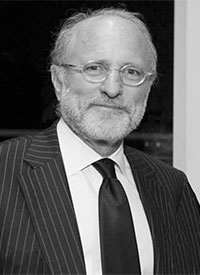
James Cuno
James Cuno is President and Chief Executive Officer of the J. Paul Getty Trust. He was elected a Fellow of the American Academy in 2001 and serves as a member of the Academy’s Commission on the Humanities and Social Sciences.
The Getty and Its Role in the World
I thought I would begin by introducing you to the Getty and its range of commitments here and abroad. Thomas will take you more deeply into the programs he directs within the Getty Research Institute. The Getty Center, which opened in 1997, includes the Research Institute, the Museum, the Conservation Institute, the Foundation, and the offices of the Trust. The Center is perched high on a hill overlooking Los Angeles, Santa Monica, Marina del Rey, and San Diego (on a clear day). But it is not meant to be up on a hill, except in the physical sense. It is meant to be deeply embedded in the lives of all who come to the hill, or who are reached by the Getty in Los Angeles and around the world. We are, of course, committed to building collections. Thomas will talk to you about the Research Institute’s collections, and I will say a few words about the Museum’s collections.
We have made two recent acquisitions. The first is a fifteenth-century Florentine drawing, Portrait of a Young Man, from about 1470. The artist is thought to be Piero del Pollaiuolo, though this attribution is not certain. In the virtually life-sized drawing, the subject’s gaze and the fact that his shirt is buttoned on the wrong side make it a very convincing drawing of someone viewing himself in a mirror. If this is true, then the drawing is not only an early portrait but a very early self-portrait, completed at the dawn of self-awareness, as the Renaissance is known.
Our second recent acquisition is a painting by Edouard Manet. The year it was completed, 1863, was the year Manet emerged as a leading innovator in French painting, the year he painted Olympia and Le Déjeuner sur l’herbe. This particular painting is a portrait of a young woman, Madame Brunet. You may think it’s wonderful, and so do we. Madame Brunet, however, did not; she rejected it. Fortunately, it stayed with Manet and his studio until later in his career, and ultimately came to the Getty.
We have two sites for the Museum, the Getty Center and a site in Malibu, which houses our ancient Mediterranean collection. But we do not just build our collections and present them in our galleries. We also provide extraordinary settings in which to see works of art. In this sense, there is a context for seeing art in the Museum, and there is a means for connecting with the world when you are here. We not only build our collections, but we teach from them. We have the rich responsibility of connecting with all our visitors, whether they come with specialized knowledge or with no knowledge, whether it is their first visit or their thirty-fifth. One of the great glories of museums is that, unlike universities, we do not examine people on arrival or on departure. We allow them to make their way as they wish, all the while providing them with informed access to different levels of comprehension or appreciation of works of art.
But we do even more than that. We also bring exhibitions to the museum to complement our collections. We are not an encyclopedic museum in the sense of having representative examples of all the world’s cultures under our roof, as the British Museum, the Metropolitan Museum of Art, and the Art Institute in Chicago do. Rather, we feature exhibitions from elsewhere, often in connection with a project that we have undertaken with another program at the museum. The Center’s four programs – Research, Conservation, Foundation, and Museum – work together in a collaborative process to deepen the impact of the Getty in the world. In the case of the exhibition Gods of Angkor: Bronzes from the National Museum of Cambodia, the Conservation Institute developed, with others, a conservation laboratory in Cambodia to conserve the sculptures. The benefits of that work are being shown in our galleries. The Aztec Pantheon and the Art of Empire, an exhibition at the Getty Villa, explored Aztec monument-building in relation to ancient Greek and Roman pantheons. Comparing these civilizations, equivalent not in date and time but in mentality, puts the ancient Mediterranean world into richer context. The exhibition Holy Image, Hallowed Ground: Icons from Sinai was the result of a collaboration between the Foundation and the Conservation Institute in Sinai. Their work in the monastery where the icons were housed led to the generous loan of the icons to the Getty Museum, presenting a bit more of the world to our visitors in Los Angeles.
We don’t just do exhibitions. We also conserve works of art that are in our collection or that come to our collection from elsewhere in the world. Working with our partner colleagues in Italy or in Eastern Europe, for example, we conserve works that then grace our galleries for a period of time so that we can share the benefit of our work with our larger public. We engage not only in applied conservation but in pure scientific research, both in the Museum and in the Conservation Institute.
Our work abroad includes a project in Ghent, Belgium, where the Foundation has supported the recent renovation, restoration, and conservation of the fifteenth-century Northern European painting The Ghent Altarpiece. One of the most important paintings in the history of art, its conservation is part of a program supporting the education of a new generation of conservators working on panel paintings. Panel paintings were the primary medium for painters in Europe from the later Middle Ages to the earliest part of the Renaissance, and the expertise for conserving them was being lost as a generation of conservators was retiring or dying without a new generation taking its place. So the Foundation identified a number of experts in the field, at the Metropolitan Museum, at the Prado Museum, and at the site in Belgium, among others. It brought these senior conservators together with younger conservators to transfer their knowledge to the next generation, to perpetuate the ability to conserve panel paintings. As another example, a team is working on a Dürer panel painting from the Prado’s collections.
A website largely supported by the Getty Foundation allows viewers to see the underdrawing beneath the painted surface of The Ghent Altarpiece via infrared reflectogram.1 The website allows you to see how the artist builds the painting from an initial drawing that guides the picture to completion. You can zoom in on the painted surface, then move beneath it with x-rays and with the infrared technology. We are very pleased by this feature and encourage you to visit the website.
Our work is not just in Europe or with European paintings; it’s elsewhere in the world, too. It’s not just with moveable objects, but includes things that do not move at all – works in Germany, for example, or King Tut’s tomb. We collaborate with local conservators not only on the scientific analysis but also on the execution of conservation. And it is not just in the Mediterranean world, but in Western China: in Dunhuang, the Getty has worked with others for decades in the execution of conservation, the analysis of preventative conservation, and the site planning to accommodate increased tourist interest in the great caves in the farthest northwest region of China, located on the Silk Road. If you were a traveler leaving China to embark on a journey along the Silk Road–into an unfamiliar world, unsure if you would return – on your way out, you would stop at the cave temples to say a few prayers. On the way back, having achieved success in your journey (and having survived), you would pause to pay gratitude. We are working not only to preserve sites such as this one, but most important, to publish the results of our work so that a collection of best practices can go on to influence the work of others after this project is completed.
Our work is not just conservation in a physical sense. In Jordan, we are developing the Middle Eastern Geodatabase for Antiquities (mega-Jordan), a rich platform for surveying and documenting the current conditions of archaeological sites. A geographic information system (GIS), written in Arabic and English, allows you to learn about the sites as well as their present conditions. Because two of the greatest threats to archaeological sites are rapid urban development and looting, the GIS allows Jordanian officials to observe the current state of archaeological sites and monitor changes from day to day. They can also use it as a means of planning how to protect the site. So when a highway is developed between one city and another, it can be designed to go around that site rather than through it. The GIS is now available as a website and software that are provided for free and can be adopted by other countries. Iraq is currently adopting the software, and that is but one example.
Most recently, I joined Thomas, Deborah Marrow, and other colleagues on a trip to India to look at two of the projects that we have been engaged in there. Two hours outside of Jodhpur is a Mughal fort in the town of Nagaur. The fort was a mess, so twenty years ago we awarded a first grant to plan, and a second to execute, its conservation. The fort’s extraordinary wall system has now been preserved, restored, and strengthened. After restoring the built structure, we teamed up with colleagues at the Courtauld Institute of Art to preserve the paintings inside. The building is a palace of mirrors with paintings that date from the seventeenth and early eighteenth centuries. The paintings were in terrible condition, and a great deal of mirrored glass had to be preserved as well. Twenty years of work went into this building, and a book was published documenting all the work done by Deborah, head of the Foundation, and colleagues including Tim Whalen, head of the Conservation Institute, and the preservation architect from India who was employed in the project. There were also local craftsmen who knew how the walls were built and therefore how to preserve them. The published results reveal best practices to be adopted by others concerned with the conservation of Mughal forts.
But we don’t just work on structures abroad. We conserve buildings here in Los Angeles. The next project of the Conservation Institute is the Eames House, an icon of mid-century modernism in Los Angeles. The house is sixty years old, and you can imagine how the metal frames for the windows, or the elements of the wall systems, have suffered over time. We are now beginning to understand how we can preserve, and not distract from, the beauty of this great house.
Our work is not just the execution of conservation but the training of a new generation of conservators. I mentioned our program that trains conservators of panel paintings. We have a similar program for conserving mosaics, called mosaikon, which is operating in the eastern part of the Mediterranean world, from Tunisia through Syria. It has not been an easy time to be involved in this region, but the Getty has benefited from the training of these conservators, who have the great responsibility to steward the safety of the legacy of ancient Rome as contained in these mosaics. Many mosaics are on-site; some have been lifted and put into museums due to a loss of knowledge of conservation and a decline in training officials to protect archaeological sites. The program is being undertaken in Rome because of the precarious situation in Tunisia, Jordan, and Syria. Fortunately, we have been able to transport Syrian conservators out of Syria to Rome, and back to Syria again, in the education process. And we are not just in Europe and the Mediterranean but in Africa, where one project trained museum management professionals and photography conservators to preserve the great legacy of photography in Africa.
The Getty Foundation also supports programs that connect art historians. For many decades, art historians have tended to focus on their own specialized field and to be in the company of only their fellow specialized art historians. The Foundation aims to bring people from a range of fields together. For example, Thomas, Deborah, Tim, and I met with colleagues at Nehru University in Delhi as part of a program the Getty has funded to introduce art historians in India to art historians with other specialties. Art history scholars in India could find themselves studying only the history of Indian art, so the program brings in art historians who specialize in Greek or Roman, medieval European, or contemporary American art, among other disciplines. With that comes not only new subject matter but different methodologies for studying the history of art. Scholars visit for a few months and then are replaced. The exchange is a way to recognize that we live in a world without borders. We bring a community of scholars together in India, or take them from India to international conferences that might occur in South America or North America.
The Foundation also encourages the publication of scholarship in print or digital form (and even as an app), and it invests locally in Los Angeles. After taking you around the world, I am bringing you back to the Pacific Standard Time exhibition here at the Getty Center. We funded the publication of a number of books and digital media showing works of art by Los Angeles artists in the postwar period, from 1945 to 1985. The exhibition began as a research project dedicated to finding, recovering, and preserving the archives of artists, dealers, collectors, museums, and galleries, to ensure that this explosive moment in the history of art in Los Angeles is saved for posterity.
To promote the conservation of the Eames House, we engaged in a kind of guerrilla activity, bringing together unlikely supporters and interested individuals to promote the project. Ice Cube (a rapper whose discography I’m sure you all have) studied architecture, and he particularly liked the Eames House and the principles employed in devising that great structure. So he helped demonstrate the public interest in our projects.
I have given you a snapshot of the Getty, and Thomas will discuss aspects of our work more deeply. We strive to do good work here and around the world, in terms of both research and applied conservation as well as presentation to our publics, scholarly and otherwise. It is an obligation we feel we have because the legacy of artistic creation in the world is common to all of us, and we want to be an important part of that legacy.
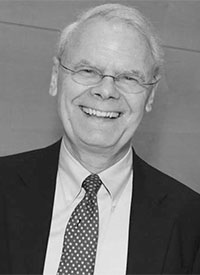
Thomas W. Gaehtgens
Thomas W. Gaehtgens is Director of the Getty Research Institute. He was elected a Fellow of the American Academy in 2011.
The Getty Research Institute’s Global Commitment to Research Projects and Resources
As Jim explained, the Getty is not only a museum, but consists of four institutions that work together: the Museum, the Conservation Institute, the Foundation, and the Research Institute. Everything depends on the cooperation of these four entities. Though this relationship between the four Getty programs is often not well understood, this arrangement provides a unique opportunity for research and for the development of public initiatives. The programs work closely together. Here on the hill, the president, vice presidents, and four directors have lunch every Monday to talk about policies and initiatives in a collaborative spirit. As part of its mission, the Getty Research Institute (GRI) “creates and disseminates new knowledge through its expertise, its active collecting program, public programs, institutional collaborations, exhibitions, publications, digital services, and residential scholars program.” The GRI is not the only Getty program involved in research – the Conservation Institute and the Museum also carry out research, and the Foundation supports research financially – but the Research Institute provides the general art-historical research component.
Our research facilities include, first of all, a library. This library is probably one of the best art history libraries in the world. With more than a million volumes of books and periodicals – no other library in the field of art history has this amount of materials – it is exceptional not only for its size, but also for the quality of the collections. That does not mean that we do not miss a book from time to time, but we try to fill the gaps. We have 3,500 periodicals and 5,500 collections of manuscripts and personal archives from artists, art historians, collectors, architects, and art dealers. Our collections are rich for contemporary art, especially since the launch of the Pacific Standard Time initiative. Collections embrace audio, video, and film as well as two million photographs in the Photo Study Collection.
Our Special Collections contain rare books, photographs, architectural models, drawings, sketchbooks, and more than 12,000 linear feet of archives. To give you an example, we have the agendas of the artist Man Ray, in which you can find appointments for “Lunch with Picasso” or “Dinner with Gertrude Stein.” We conserve rare photographs, as well as nearly 68,000 rare books, including materials from the fifteenth century to the present. The GRI is a treasure trove of material for studying the history of art.
One of our aims is to support and develop the discipline of art history. Our Scholars Program invites researchers from all over the world to work on an annual research topic. In 2011, the topic was the Display of Art. This year, we are working on Artistic Practice. Next year, the subject will be Color. We try to bring together scholars from different backgrounds. Lectures, colloquia, and perhaps even exhibitions or publications develop from the year, half-year, or three months the scholars spend at the GRI. We host about fifty scholars annually. Some of them are delegated to the program from the Museum and from the Conservation Institute. The GRI oversees the administration of all these Getty scholars.
Given that art history is largely a Western discipline, most of our visiting scholars are from Europe, the United States, and Canada. Of the 803 scholars that have received residential Getty scholarships since 1985, 410 have come from the United States and 393 from other countries. The program is still very Western-oriented, and we are endeavoring to change that. The challenge is not only the discipline’s Western focus, but also that our resources are predominantly Western. We have to expand our collections to represent the artistic traditions from other countries and to reflect this new global world. We have begun to take on this enormous challenge. In October 2012, for example, we will hold a symposium in Beijing on the subject of artistic exchanges between China and the West. Additionally, we will invite sixteen students and eight professors to our Summer Research Academy, bringing Western professors and students together with colleagues from other cultures. To support such programs, we work closely with the Getty Foundation.
Another focus is our digitizing initiative. In the past few years, we have digitized an impressive 2.6 million images. The seven thousand books we have digitized are not sufficient, but we will do more to increase this number. Though we face limitations in staff and resources, we will continue to digitize books and share them on the Internet, so that they can be consulted and read all over the world, especially where scholars may not have access to this art-historical literature. We are currently developing a project that will revolutionize the discipline of art history: together with the Avery Architectural and Fine Arts Library at Columbia University, the Frick Art Reference Library, and the Thomas J. Watson Library of the Metropolitan Museum of Art in New York; the Biblioteca de la Universidad de Málaga in Málaga, Spain; the Institut national d’histoire de l’art in Paris; and the Universitätsbibliothek Heidelberg in Heidelberg, Germany, we are digitizing the entire literature of the history of art before 1923. (Because 1923 is the American copyright date, we cannot digitize material published after that year.) We are bringing all this literature into a portal so that readers can access it whether they are in Peru, Germany, Russia, or China. From the beginning, the project has focused not only on Western art history but also on art from China, India, Brazil, and other countries. We plan to launch this digital library on May 31, 2012. In a couple of years, it will certainly be a major tool to conduct art historical research.
The Getty vocabularies form another important project. Consider this example: the Mona Lisa is also known as the Portrait of Lisa Gherardini, La Gioconda, and La Joconde. All these different descriptions have to be linked for a computer search to recognize all the variable titles used for the Mona Lisa. Even more important, the vocabs can be used all over the world because they are being translated into numerous languages. The Research Institute continues to develop this essential tool.
Another research tool is the Provenance Index, a vast database of inventories, sale catalogs, and collection catalogs. Take for example a beautiful painting by Rubens at the Getty Museum, The Entombment, which should really be called Lamentation, completed circa 1612. When the Getty bought this painting from a catalog, no one knew exactly what had happened to it before 1868. On the surface of the picture is the number 146, and if one types Rubens and 146 into the search boxes of the Getty Research Provenance Index, one learns that this painting was in the collection of Gaspar de Haro y Guzmán in Spain, from 1600 to 1653. This database documents the painting’s entire history up to the nineteenth and twentieth centuries, demonstrating how important this resource is for the art market, for the art collector, and for those who are interested in the reception of paintings. It is a vital tool for art history in general.
The Getty Research Institute is also engaged in a number of research projects, including: the Art of Alchemy; Art on Screen; Book Art of the Russian Avant-Garde; The Display of Art in Roman Palaces, 1550–1750; German Sales, 1930–45: Art Works, Art Markets, and Cultural Policy; Los Angeles Architecture, 1940–1990; Orientalist Photography; Pacific Standard Time; Printmaking in the Age of Louis xiv, 1660–1715; Surrealism in Latin America; and The Future of Art Bibliography.
How do we come up with all these research projects? We conceptualize them by looking for ways to make our collections accessible to the public. We find scholars who can help us and invite them to work on these projects. For instance, The Display of Art in Roman Palaces was launched because we have a large number of inventories of Roman palaces. Los Angeles Architecture will be a major exhibition next year at the Getty Museum. Pacific Standard Time is the initiative that started with the collections of the GRI and, as Jim mentioned, is funded by the Foundation; we participated in curating the exhibition at the Getty Museum. In two weeks, the Pacific Standard Time exhibition will travel to Berlin.
We are trying to incorporate a global focus into our work. We will not give up our past in art history as a Western discipline, but will expand it to include the topic of encounters between different cultures. Because of our location in California, with close proximity to Mexico, Latin America is of significant interest to us, and we have a major collection of Latin American art historically relevant photographs and other materials. Furthermore, the GRI holds scholarly resources on Chinese art, and we are trying to be more involved in India, the Near East, and Africa, as you can see from our exhibitions.
Managing the abundance of material on the GRI’s website is a challenge. Because our website has 32,000 pages, it is difficult to find what one is searching for. Making all our material accessible to the outside world is impossible, but we are trying to make a significant number of our resources available to our many online visitors. From May 1, 2009, to February 27, 2012, we had more than 2.6 million visits to the website, including 1.7 million from the United States, 131,911 from England, and significant numbers from other Western countries. Outside the West, the numbers diminish. There were 27,956 visits from Mexico and 18,823 from India. That we have 17,723 online visits from Brazil probably reflects the fact that the Getty Foundation and the Research Institute traveled to Brazil to develop a new initiative, which the Foundation is funding, to connect the international art-historical community with that of Brazil. By contrast, online visits from Japan totaled only 17,312; from Russia, 17,405; from China, 14,711; and from Taiwan, 10,079.
We still have a lot of work ahead of us to move Western art history into the global present. We have to make our vast resources accessible to scholars in other countries, where these resources may not exist. As a philanthropic institution, we are proud to provide free access to our materials. The maps and statistics I have shown in this presentation indicate where more engagement is needed in the future.
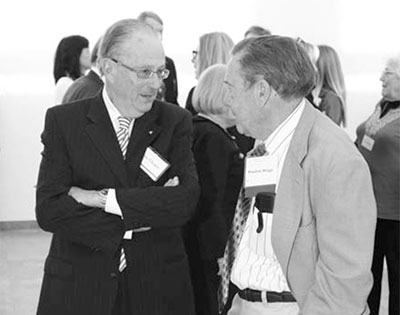
|
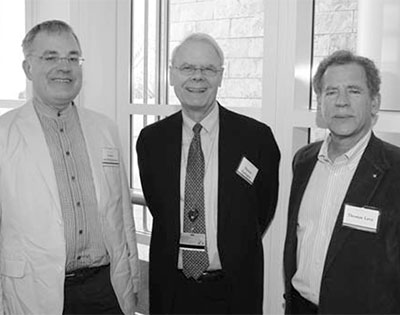
|
| Jesse Choper (UC Berkeley School of Law) and Winslow Briggs (Carnegie Institution for Science) |
Lothar von Falkenhausen (University of California, Los Angeles), Thomas Gaehtgens (Getty Research Institute), and Thomas Levy (University of California, San Diego) |
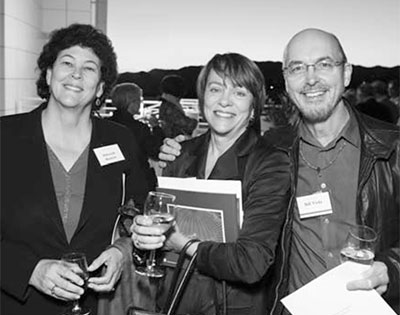
|
|
|
Deborah Marrow (The Getty Foundation), Louise Bryson (J. Paul Getty Trust), and Bill Viola (Bill Viola Studio) |
ENDNOTES
1 “Closer to Van Eyck: Rediscovering the Ghent Altarpiece,” http://closertovaneyck.kikirpa.be/#home.© 2012 by James Cuno and Thomas W. Gaehtgens, respectively